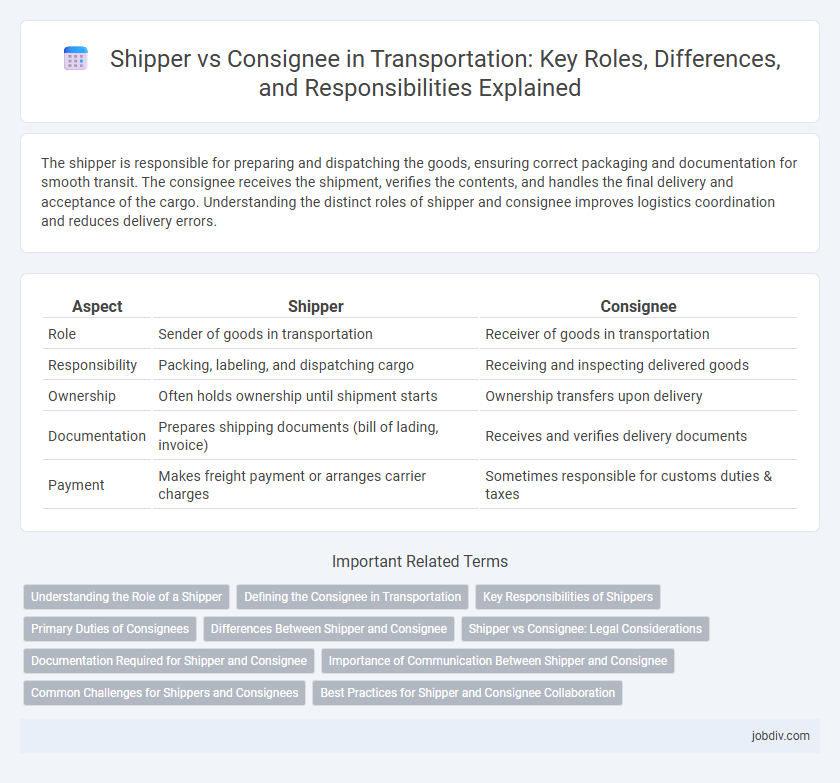The shipper is responsible for preparing and dispatching the goods, ensuring correct packaging and documentation for smooth transit. The consignee receives the shipment, verifies the contents, and handles the final delivery and acceptance of the cargo. Understanding the distinct roles of shipper and consignee improves logistics coordination and reduces delivery errors.
Table of Comparison
| Aspect | Shipper | Consignee |
|---|---|---|
| Role | Sender of goods in transportation | Receiver of goods in transportation |
| Responsibility | Packing, labeling, and dispatching cargo | Receiving and inspecting delivered goods |
| Ownership | Often holds ownership until shipment starts | Ownership transfers upon delivery |
| Documentation | Prepares shipping documents (bill of lading, invoice) | Receives and verifies delivery documents |
| Payment | Makes freight payment or arranges carrier charges | Sometimes responsible for customs duties & taxes |
Understanding the Role of a Shipper
The shipper is responsible for initiating the transportation process by preparing and dispatching goods, ensuring accurate documentation, and complying with shipping regulations. This role includes coordinating with carriers to arrange shipment and managing risks related to packaging and labeling. Proper understanding of the shipper's duties is crucial for efficient logistics and timely delivery in supply chain management.
Defining the Consignee in Transportation
The consignee in transportation refers to the individual or entity designated to receive goods or cargo at the destination as specified on the shipping document. This party holds the legal right to claim possession and is responsible for accepting the delivery and verifying the shipment's condition upon arrival. Understanding the consignee's role is crucial for ensuring accurate delivery, customs clearance, and liability management in logistics operations.
Key Responsibilities of Shippers
Shippers are responsible for accurately preparing and packaging goods to ensure safe transportation and compliance with regulatory requirements. They must provide precise shipping documentation, including bills of lading and customs declarations, to facilitate smooth logistics operations. Coordinating with carriers and arranging timely pickups are also critical duties to maintain efficient supply chain workflows.
Primary Duties of Consignees
Consignees are responsible for receiving, inspecting, and signing off on shipments upon delivery to ensure goods meet quality and quantity specifications. They coordinate with carriers to manage delivery schedules and handle any discrepancies or damages reported during transit. Proper documentation and timely communication with shippers and freight forwarders are critical duties to maintain shipment accuracy and compliance.
Differences Between Shipper and Consignee
The shipper is the party responsible for initiating the shipment by packing and sending goods, whereas the consignee is the recipient designated to receive the shipment at its destination. Shippers handle documentation, regulatory compliance, and payment of shipping fees, while consignees focus on accepting delivery, inspecting goods, and managing receipt confirmation. In logistics, distinguishing these roles ensures accountability and smooth transfer of ownership during the transportation process.
Shipper vs Consignee: Legal Considerations
Shipper and consignee have distinct legal responsibilities in transportation agreements, with the shipper primarily accountable for accurate shipment documentation and compliance with export regulations. The consignee holds legal rights to claim delivery and is responsible for import duties and customs clearance. Understanding these legal roles is essential to mitigate liability and ensure smooth transactional processes in logistics.
Documentation Required for Shipper and Consignee
Shippers must provide comprehensive documentation such as the commercial invoice, packing list, and export declaration to ensure compliance with customs regulations and accurate shipment processing. Consignees are responsible for submitting the bill of lading, import permits, and customs clearance documents to facilitate the proper receipt and legal entry of goods into the destination country. Both parties must maintain accurate records to avoid delays and disputes during transportation and delivery.
Importance of Communication Between Shipper and Consignee
Effective communication between shipper and consignee ensures accurate shipment details are exchanged, minimizing errors and delays in delivery. Clear dialogue facilitates timely updates on shipment status, enabling better coordination in logistics and inventory management. Seamless interaction boosts trust and efficiency, ultimately enhancing the entire transportation process.
Common Challenges for Shippers and Consignees
Shippers often face challenges related to accurate documentation, timely cargo pickup, and compliance with regulatory requirements, while consignees commonly encounter issues with delivery delays, damaged goods, and coordination for cargo unloading. Both parties must manage communication gaps and discrepancies in shipment tracking information to ensure smooth logistics operations. Efficient collaboration between shippers and consignees is critical to minimizing risks and optimizing the supply chain flow.
Best Practices for Shipper and Consignee Collaboration
Effective communication between shipper and consignee minimizes delays and ensures accurate delivery of goods. Implementing real-time tracking technologies and sharing shipment updates enhance transparency and coordination throughout the supply chain. Establishing clear responsibilities and standardized documentation streamlines customs clearance and reduces disputes, optimizing logistics efficiency.
Shipper vs Consignee Infographic

 jobdiv.com
jobdiv.com